![]()
![]()
![]()
Use LEFT and RIGHT arrow keys to navigate between flashcards;
Use UP and DOWN arrow keys to flip the card;
H to show hint;
A reads text to speech;
86 Cards in this Set
- Front
- Back
|
Pumps |
Used to increase the pressure of an incompressible fluid. Energy is transferred to the fluid |
|
|
Compressors |
Used to compress a steady flow of gas. Energy is transferred to the fluid |
|
|
Does temperature and pressure increase or decrease within a compressor |
Increase |
|
|
Turbine |
Used to produce mechanical power from a steady flow of either liquid or gas. Energy is transferred from the fluid |
|
|
Does pressure increase or decrease in a turbine |
Decrease |
|
|
Turbomachinery |
Understanding the transfer of energy between a fluid and rotating machine |
|
|
How are turbomachines identified |
1) primary components are rotative 2) steady flow conditions exist at inlet and exit to machine |
|
|
Types of turbomachine |
Axial flow Radial flow Mixed flow |
|
|
What forces are exerted on the solid wall by fluids |
Static pressure (normal) Shear stress (tangential) |
|
|
Where are the changes in forces of the axial and radial forces imposed |
Shaft bearing |
|
|
Absolute velocity |
Velocity seen by a stationary observer |
|
|
Relative velocity |
Velocity seen by an observer moving with the blade |
|
|
Blade velocity |
The velocity at the reference point on the blade |
|
|
Are static and total properties dependant on the frame of reference |
Static - independant Total - dependant |
|
|
Eulers equation |
Rate of change of angular momentum of a fluid equals the torque on the rotor |
|
|
What occurs in pumps and compressors |
Energy is transferred to the fluid by action of the rotating impeller |
|
|
How does the transfer of energy occur in a compressor |
By increasing radius of rotor By increasing flow velocity |
|
|
How does a radial compressor work |
Flow enter the eye in an axial direction The impeller turns the flow into a radial flow as it goes toward the tip The flow then travels into the vaneless space It then enters a vaned diffuser and is released axially through the volute |
|
|
What is the typical pressure ratio in the radial compressor |
8:1 |
|
|
Where are centrifugal compressors used |
Turbochargers |
|
|
Why are impeller blades shaped |
To accept the flow smoothly |
|
|
Why does slip occur |
The inertia of the passing air is not the same as that of the impeller blade |
|
|
Is any energy gained in the boneless space |
No |
|
|
When are vaneless and Vaned diffuser used |
Vaneless - wide range of mass flows Vaned - applications where high efficiency is required |
|
|
blade angles |
Radial blades - β = 0 Backswept blades - β > 0 Forward swept blades - β < 0 |
|
|
Effects of blade angle |
Radial blades - Δp independent of Q Backswept blades - Δp decreases with Q Forward swept blades - Δp increases with Q
Q - volumetric flow rate |
|
|
Which sweep of blade is most stable and why |
Backswept Because forward swept increases the risk of surge |
|
|
Can radial compressors be easily multistaged |
No |
|
|
What happens to the gas in a radial flow turbine |
Flow enters at a high tangential velocity directed inwards and leaves the rotor with as small a whirl velocity as practice near the axis of rotation |
|
|
Difference between a radial turbine and centrifugal compressors |
Diffuser vanes replace nozzle guide vanes A diffuser downstream to reduce exit velocity to a negligible value |
|
|
Dimensional homogeneity |
All terms in the function must have the same units as Q1 |
|
|
Buckingham pi theorem |
If n physical parameters define a situation and we can express these in r independent fundamental quantities the the relationship may be reduced to one between n-r dimensionless products |
|
|
Typical operating characteristics of a centrifugal fan graph |
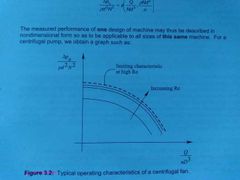
|
|
|
Performance map of a centrifugal compressor |
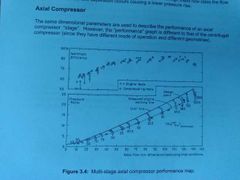
|
|
|
What does a constant radial height mean in an axial compressor |
The blade speed is fixed between inlet and outlet of blade row |
|
|
What is the flow regime of an axial turbine |
Flow accelerates and flow passage converges |
|
|
What is the flow regime of an axial compressor |
Flow diffuses and flow passage diverges |
|
|
Pressure ratio of an axial compressor |
1.2-1.3 |
|
|
What does one stage consist of for an axial compressor |
Bladed rotor and a set of fixed stator vanes |
|
|
How does the blade shape effect the flow |
It causes the flow to be continuous |
|
|
How do the rotors and stairs work in an axial compressor |
Rotors - absorb power Stators - convert kinetic energy to static pressure |
|
|
Is total temperature constant within an axial compressor |
Yes |
|
|
Flow velocity and static pressure diagrams for an axial compressor |
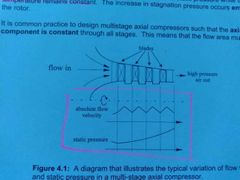
|
|
|
What is the role of the stator blades |
Reduce absolute velocity and increase static pressure Return swirling to near axial direction |
|
|
Limitations of a staged pressure rise |
Blade speed Axial velocity A high value of β2 - β1 |
|
|
Conditions for having varying degrees of reaction |
Constant axial velocity Constant value speed Constant difference in flow relative flow angle |
|
|
Reactions for different blade designs inc velocity triangles |
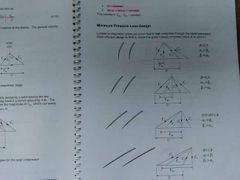
|
|
|
Rotating stall |
One or several adjacent rotor blade passages become stalled. |
|
|
What does rotating stall cause to happen |
A reduction in mass flow rate through the affected passages a change in flow direction Reduction in local blade incidence
|
|
|
Deep stall |
When most or all of the blade passages have ceased to operate normally |
|
|
Surge |
All rotor passages are continually changing between stalled and installed conditions which causes a change in flow direction |
|
|
What causes stall and surge |
Rapid increase in shaft speed Engine intake flow distortion |
|
|
Constant speed characteristic graph with explanation |

Point A - mass flow rate = 0 Point C - no pressure rise but high flow rate A-B - unstable region Point B - surge point B-C - stable region |
|
|
Surge process |
Mass flow rate reduces slightly Operating point moves further left Incidence angle increases and blade stall worsens Pressure delivery falls Flowers in compressor is reversed As downstream pressure falls the compressor is able to start up again |
|
|
The design point |
The point where losses are not excessive for a compressor |
|
|
What does an axial flow turbine consist of |
A row of fixed guide vanes/nozzels followed by a row of rotor blades |
|
|
Process for an axial flow turbine |
The flow accelerates through the stairs and is turned in a tangential direction. The flow is accelerated again as it goes through the rotor passage in the relative reference frame. Energy is extracted by the rotors and the nozzles expand the flow to sonic conditions and discharge it at an angle so that tangential momentum is converted to work |
|
|
How do pressure losses within a turbine occur |
Friction Flow turning effects Stalling effects at low incidence |
|
|
Axial turbine velocity triangle |
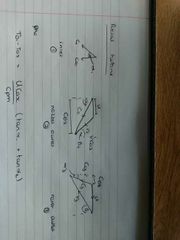
|
|
|
What do the different reactions relate to |
50% - there is equal enthalpy drops across the stator and rotor blades 0% - all the static temperature occurs across the stator vanes |
|
|
Another name for polytropic efficiency |
Aerodynamic efficiency |
|
|
Types of engine |
Turboprop Turbofan Turbojet |
|
|
Factors affecting the choice of engine |
Fuel burn Flight speed Mission profile Cost Life |
|
|
Brayton cycle graph + explanation |
Pic |
|
|
Engine propulsion efficiency graph |
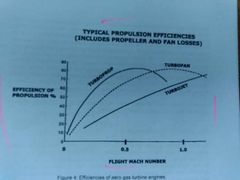
|
|
|
Conditions for a fully expanded flow |
Pn=Patm |
|
|
Net thrust |
Rate of increase of momentum of the air |
|
|
Thermal efficiency |
Ratio of useful work to fuel input |
|
|
Pressure ratio Vs thermal efficiency graph |
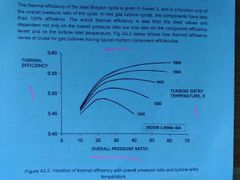
|
|
|
Propulsion efficiency |
Ability of the increase in kinetic energy to provide thrust |
|
|
Specific fuel consumption |
Fuel rate required per unit thrust |
|
|
Specific thrust |
Net thrust per unit intake airflow |
|
|
Brayton cycle graphs |
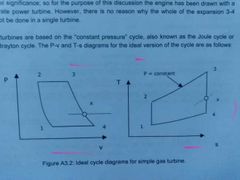
|
|
|
Brayton cycle process |
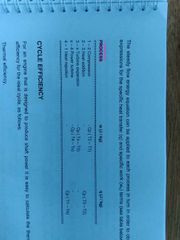
|
|
|
What are the 2 conditions for the fan |
1) The work from the turbine must match that supplied to the fan by the compressor 2) the pressure at the point at which the core and bypass streams mix must be the same |
|
|
Radial impeller velocity triangle |
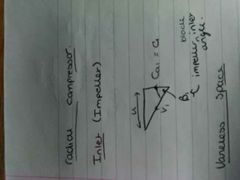
|
|
|
T-S diagram for radial conpression |

|
|
|
Axial flow compressor velocity triangles |

|
|
|
How do u find the pressures when no initial pressure is given (complete engine Calculation) |
Put everything in terms of Pt0 and cancel when necessary |
|
|
What is the total pressure at the end of the bypass |
Equal to the inlet pressure of the compressor |
|
|
Impeller exit velocity triangle |

|
|
|
For a 50% axial flow compressor what are the angles |
β1=α2 β2=α1 |
|
|
Key for velocity triangles |
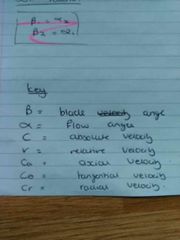
|
|
|
For axial flow turbines what are the angles for the different reactions |
50% β3=α2 0% β3=β2 |
|
|
What are the differences between axial and radial compression maps |
Impeller more tolerant of changes in mass flow rate Radial is relatively flat with a high stall margin (further enhanced by back sweeping) Axial compressors have a narrow mass flow range and small surge margin |
|
|
What is power equal to |
Work done |

